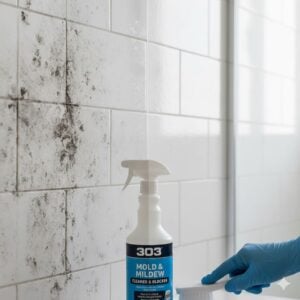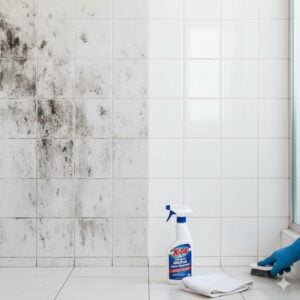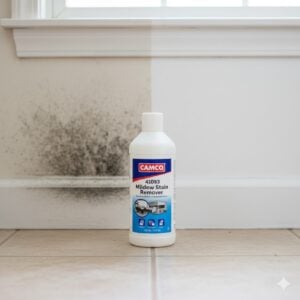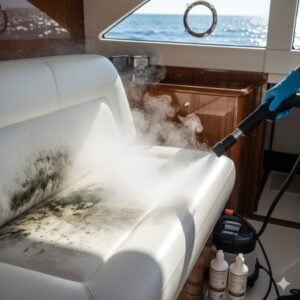Black mold is one of the most common and persistent household problems in humid climates like the UAE. It thrives on moisture, poor ventilation, and hidden leaks. Many people turn to popular cleaning products such as CLR Mold & Mildew Remover, hoping for a quick fix. But does CLR mold and mildew really kill black mold—or does it simply clean the surface? Let’s dive into how this product works, its limitations, and when professional help becomes necessary for safe and lasting results.
Table of Contents
ToggleUnderstanding Black Mold
Before answering whether CLR kills it, it’s important to understand what black mold is. The most well-known strain, Stachybotrys chartarum, appears as dark greenish-black patches on walls, ceilings, tiles, or fabrics. It feeds on organic materials such as drywall, paper, and dust. Unlike surface mildew, black mold grows deep into porous materials, producing mycotoxins that can affect air quality and health if left untreated.
Exposure to black mold can cause allergic reactions, respiratory irritation, and fatigue. While small areas might seem harmless, hidden mold colonies can multiply rapidly under humid conditions, especially around bathrooms, AC vents, and kitchens.
What Is CLR Mold & Mildew Remover?
CLR Mold & Mildew Remover is a commercial cleaning spray widely sold in supermarkets and hardware stores. Its formula is designed to remove mold and mildew stains using bleach-based agents and surfactants. The product’s main goal is to clean visible growth, sanitize hard surfaces, and brighten discolored areas such as tiles, tubs, and showers.
While it’s marketed as effective for general mold and mildew, CLR is primarily a stain remover, not a long-term mold remediation solution. It helps wipe away the top layer of mold but doesn’t necessarily penetrate deep surfaces where spores continue to grow.
How CLR Mold and Mildew Works
The active ingredients in CLR include bleach-like compounds that react with mold stains. When sprayed on hard surfaces such as ceramic, glass, or metal, it breaks down the pigment and sanitizes the area temporarily. This chemical action removes visible mold colonies, giving the appearance of cleanliness. However, this effect is mostly surface-level for non-porous materials.
On porous materials like drywall, wood, and grout, the cleaner cannot reach deep-rooted spores. These spores can survive and reappear once humidity returns. Thus, CLR’s effectiveness depends heavily on the type of surface and how severe the infestation is.
Does CLR Kill Black Mold Completely?
CLR Mold & Mildew Remover can kill and remove surface-level black mold on non-porous areas. However, it does not eliminate black mold entirely when the infestation extends into porous materials. Think of it as a cosmetic solution—it makes surfaces look clean but may not stop the mold from returning.
According to product directions, it’s intended for ceramic tile, shower walls, fiberglass, and sealed concrete. These are surfaces where mold can be physically wiped away. But if black mold has grown inside drywall, under paint, or within insulation, CLR cannot reach those internal layers. Spores left behind quickly multiply once moisture returns.
Testing CLR’s Effectiveness on Different Surfaces
Here’s a closer look at how well CLR works on common household materials:
| Surface Type | Effectiveness | Recommendation |
|---|---|---|
| Ceramic tile or porcelain | High – Removes visible mold stains effectively | Safe to use with scrubbing and proper ventilation |
| Grout or caulk | Moderate – Cleans surface mold, but deep spores may survive | Requires sealing after cleaning to prevent regrowth |
| Drywall, wood, or paint | Low – Cannot penetrate to remove deep mold | Needs professional mold remediation |
| Fabric or carpet | Very Low – May cause discoloration without killing spores | Best handled by textile restoration specialists |
Safety Considerations When Using CLR
Because CLR contains strong cleaning agents, safety precautions are essential:
- Always wear gloves and eye protection when using CLR.
- Ensure proper ventilation to avoid inhaling fumes.
- Never mix CLR with ammonia, vinegar, or other cleaners—it can release toxic gases.
- Rinse surfaces thoroughly after cleaning to remove residue.
- Keep pets and children away until the area is fully dry.
Remember that black mold is a biological problem, not just a cosmetic one. While CLR cleans visible stains, it doesn’t neutralize airborne spores or toxins that may still circulate indoors.
Alternative Methods for Killing Black Mold
Aside from CLR, several other cleaning agents can be used for small, non-porous mold patches:
- Hydrogen peroxide (3%) – Kills mold and disinfects surfaces without harsh fumes.
- White vinegar – Slightly acidic, kills about 80% of mold species and deodorizes.
- Baking soda – Works as a natural scrubbing agent when mixed with water or vinegar.
- Commercial mold removers – Designed for deeper disinfection, though many contain bleach.
However, these are still temporary solutions. When mold covers an area larger than one square meter, or if you notice recurring stains, professional intervention becomes critical to ensure complete removal and safety.
Professional Mold Remediation vs. Store Cleaners
Professional mold remediation involves more than wiping and spraying. Experts like Bio-On UAE conduct root-cause inspections to find moisture sources, test air quality, and remove contaminated materials safely. Using HEPA-filtered vacuums and commercial-grade biocides, professionals eliminate spores hidden inside walls or ducts.
Unlike CLR, professional cleaning targets mold both on and below the surface, preventing regrowth. This process also includes drying and dehumidification, which is crucial in UAE’s humid environment where moisture quickly triggers new outbreaks.
Why DIY Mold Removal Can Be Dangerous
DIY cleaning with CLR or similar products poses several risks:
- Incomplete removal: Hidden mold continues to grow underneath surfaces.
- Health hazards: Scrubbing can release spores into the air, increasing exposure.
- Chemical sensitivity: Bleach fumes may irritate eyes, throat, or lungs.
- Surface damage: Misuse of chemical cleaners can discolor paint or corrode metals.
These risks multiply in enclosed spaces like bathrooms or storage rooms. Without proper protective gear and ventilation, even a minor cleaning session can lead to respiratory irritation.
How Bio-On UAE Handles Black Mold Safely
Bio-On UAE uses a scientific, step-by-step process for complete mold remediation:
- Inspection and assessment: Identifying affected zones, hidden leaks, and humidity sources.
- Containment: Preventing spores from spreading to other rooms using plastic barriers and air scrubbers.
- HEPA vacuuming: Removing dry mold particles from walls and ceilings.
- Antimicrobial treatment: Applying non-toxic biocides that penetrate porous surfaces.
- Dehumidification: Using commercial dryers to stabilize moisture levels.
- Final testing: Ensuring air quality meets municipal standards.
This approach goes far beyond CLR’s surface cleaning. Bio-On UAE doesn’t just clean what you see — it eliminates the invisible causes of mold growth and restores your home to a safe, breathable condition.
Cost of Professional Mold Removal in UAE
Pricing varies depending on contamination level and surface area. Typical mold treatment costs in the UAE are:
- Up to 1 sq.m: AED 35 per sq.m.
- 1–3 sq.m: AED 30 per sq.m.
- 3–7 sq.m: AED 25 per sq.m.
- 7–10 sq.m: AED 20 per sq.m.
- Over 10 sq.m: Free inspection by Bio-On UAE.
Additional air quality or lab testing (optional) ranges from AED 1000 per analysis. This pricing ensures full treatment and verification rather than temporary fixes. Compared to repeated DIY attempts, professional cleaning is more cost-efficient long-term.
When to Call a Professional
If you notice black patches returning after cleaning, musty smells, or health symptoms such as coughing or eye irritation, don’t rely on over-the-counter products. Persistent mold means deeper contamination. A professional inspection ensures safety and prevents costly property damage.
In apartments or villas with AC systems, mold can spread through air ducts, making surface cleaning useless. Bio-On UAE’s technicians are trained to detect and treat such cases efficiently using advanced drying and filtration systems.
Long-Term Mold Prevention Tips
- Fix leaks immediately and check plumbing regularly.
- Run exhaust fans or dehumidifiers in bathrooms and kitchens.
- Clean AC filters monthly to prevent moisture buildup.
- Keep humidity below 60% indoors.
- Schedule annual inspections for mold-prone areas.
Preventing mold is easier and cheaper than removing it. Combining regular maintenance with professional cleaning when needed helps you avoid health risks and property damage.
Conclusion
So, does CLR Mold & Mildew Remover kill black mold? The answer: partially. It cleans and sanitizes non-porous surfaces effectively but doesn’t eliminate black mold colonies embedded deep within walls or fabrics. For complete and safe removal, professional mold remediation is essential. In the UAE, Bio-On provides the most reliable solution, combining inspection, disinfection, and prevention into one seamless process. If you’re tired of mold coming back no matter how much you clean, it’s time to call the experts and make your home truly mold-free.













